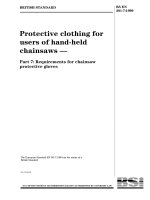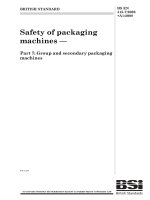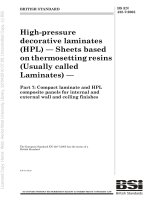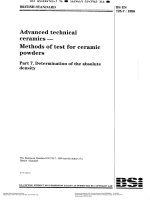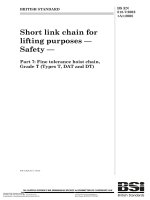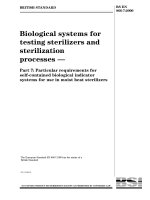Bsi bs en 61800 7 301 2016
Bạn đang xem bản rút gọn của tài liệu. Xem và tải ngay bản đầy đủ của tài liệu tại đây (6.45 MB, 164 trang )
BS EN 61800-7-301:2016
BSI Standards Publication
Adjustable speed electrical
power drive systems
Part 7-301: Generic interface and use of
profiles for power drive systems — Mapping
of profile type 1 to network technologies
BS EN 61800-7-301:2016 BRITISH STANDARD
National foreword
This British Standard is the UK implementation of EN 61800-7-301:2016. It
is identical to IEC 61800-7-301:2015. It supersedes BS EN 61800-7-301:2008,
which will be withdrawn on 12 October 2018.
The UK participation in its preparation was entrusted to Technical
Committee PEL/22, Power electronics.
A list of organizations represented on this committee can be obtained on
request to its secretary.
This publication does not purport to include all the necessary provisions of
a contract. Users are responsible for its correct application.
© The British Standards Institution 2016.
Published by BSI Standards Limited 2016
ISBN 978 0 580 82132 5
ICS 29.200; 35.100.05
Compliance with a British Standard cannot confer immunity from
legal obligations.
This British Standard was published under the authority of the
Standards Policy and Strategy Committee on 31 March 2016.
Amendments/corrigenda issued since publication
Date Text affected
EUROPEAN STANDARD BS EN 61800-7-301:2016
NORME EUROPÉENNE
EUROPÄISCHE NORM EN 61800-7-301
ICS 29.200; 35.100.05 February 2016
Supersedes EN 61800-7-301:2008
English Version
Adjustable speed electrical power drive systems -
Part 7-301: Generic interface and use of profiles for power drive
systems - Mapping of profile type 1 to network technologies
(IEC 61800-7-301:2015)
Entrnements électriques de puissance à vitesse variable - Elektrische Leistungsantriebssysteme mit einstellbarer
Partie 7-301: Interface générique et utilisation de profils Drehzahl - Teil 7-301: Generisches Interface und Nutzung
pour les entrnements électriques de puissance - Mise en von Profilen für Leistungsantriebssysteme (PDS) -
correspondance du profil de type 1 avec les technologies Abbildung von Profil-Typ 1 auf Netzwerktechnologien
de réseaux (IEC 61800-7-301:2015)
(IEC 61800-7-301:2015)
This European Standard was approved by CENELEC on 2015-12-25. CENELEC members are bound to comply with the CEN/CENELEC
Internal Regulations which stipulate the conditions for giving this European Standard the status of a national standard without any alteration.
Up-to-date lists and bibliographical references concerning such national standards may be obtained on application to the CEN-CENELEC
Management Centre or to any CENELEC member.
This European Standard exists in three official versions (English, French, German). A version in any other language made by translation
under the responsibility of a CENELEC member into its own language and notified to the CEN-CENELEC Management Centre has the
same status as the official versions.
CENELEC members are the national electrotechnical committees of Austria, Belgium, Bulgaria, Croatia, Cyprus, the Czech Republic,
Denmark, Estonia, Finland, Former Yugoslav Republic of Macedonia, France, Germany, Greece, Hungary, Iceland, Ireland, Italy, Latvia,
Lithuania, Luxembourg, Malta, the Netherlands, Norway, Poland, Portugal, Romania, Slovakia, Slovenia, Spain, Sweden, Switzerland,
Turkey and the United Kingdom.
European Committee for Electrotechnical Standardization
Comité Européen de Normalisation Electrotechnique
Europäisches Komitee für Elektrotechnische Normung
CEN-CENELEC Management Centre: Avenue Marnix 17, B-1000 Brussels
© 2016 CENELEC All rights of exploitation in any form and by any means reserved worldwide for CENELEC Members.
Ref. No. EN 61800-7-301:2016 E
BS EN 61800-7-301:2016
EN 61800-7-301:2016
European foreword
The text of document 22G/311/FDIS, future edition 2 of IEC 61800-7-301, prepared by
SC 22G “Adjustable speed electric drive systems incorporating semiconductor power converters” of
IEC/TC 22 “Power electronic systems and equipment" was submitted to the IEC-CENELEC parallel
vote and approved by CENELEC as EN 61800-7-301:2016.
The following dates are fixed:
• latest date by which the document has to be (dop) 2016-09-25
implemented at national level by (dow) 2018-12-25
publication of an identical national
standard or by endorsement
• latest date by which the national
standards conflicting with the
document have to be withdrawn
This document supersedes EN 61800-7-301:2008.
Attention is drawn to the possibility that some of the elements of this document may be the subject of
patent rights. CENELEC [and/or CEN] shall not be held responsible for identifying any or all such
patent rights.
Endorsement notice
The text of the International Standard IEC 61800-7-301:2015 was approved by CENELEC as a
European Standard without any modification.
In the official version, for Bibliography, the following notes have to be added for the standards indicated:
IEC 61158 Series NOTE Harmonized as EN 61158 Series.
IEC 61499-1 NOTE Harmonized as EN 61499-1.
IEC 61784-1 NOTE Harmonized as EN 61784-1.
IEC 61784-2 NOTE Harmonized as EN 61784-2.
IEC 61800 Series NOTE Harmonized as EN 61800 Series.
IEC 61800-7-1:2015 NOTE Harmonized as EN 61800-7-1:2016 (not modified).
IEC 61800-7-202:2015 NOTE Harmonized as EN 61800-7-202:2016 (not modified).
IEC 61800-7-203:2015 NOTE Harmonized as EN 61800-7-203:2016 (not modified).
IEC 61800-7-204:2015 NOTE Harmonized as EN 61800-7-204:2016 (not modified).
IEC 61800-7-302:2015 NOTE Harmonized as EN 61800-7-302:2016 (not modified).
IEC 61800-7-303:2015 NOTE Harmonized as EN 61800-7-303:2016 (not modified).
IEC 61800-7-304:2015 NOTE Harmonized as EN 61800-7-304:2016 (not modified).
IEC 61915-1 NOTE Harmonized as EN 61915-1.
2
BS EN 61800-7-301:2016
EN 61800-7-301:2016
Annex ZA
(normative)
Normative references to international publications
with their corresponding European publications
The following documents, in whole or in part, are normatively referenced in this document and are
indispensable for its application. For dated references, only the edition cited applies. For undated
references, the latest edition of the referenced document (including any amendments) applies.
NOTE 1 When an International Publication has been modified by common modifications, indicated by (mod), the relevant
EN/HD applies.
NOTE 2 Up-to-date information on the latest versions of the European Standards listed in this annex is available here:
www.cenelec.eu
Publication Year Title EN/HD Year
-
IEC 61158-4-14 - Industrial communications subsystem EN 50325-4 -
IEC 61158-5-12 - based on ISO 11898 (CAN) for controller- -
IEC 61158-5-13 - device interfaces - -
IEC 61158-5-14 - Part 4: CANopen -
IEC 61158-5-23 - -
IEC 61158-6-12 - Industrial communication networks - EN 61158-4-14 -
IEC 61158-6-13 - Fieldbus specifications - -
Part 4-14: Data-link layer protocol
specification - Type 14 elements
Industrial communication networks - EN 61158-5-12
Fieldbus specifications -
Part 5-12: Application layer service
definition - Type 12 elements
Industrial communication networks - EN 61158-5-13
Fieldbus specifications -
Part 5-13: Application layer service
definition - Type 13 elements
Industrial communication networks - EN 61158-5-14
Fieldbus specifications -
Part 5-14: Application layer service
definition - Type 14 elements
Industrial communication networks - EN 61158-5-23
Fieldbus specifications -
Part 5-23: Application layer service
definition - Type 23 elements
Industrial communication networks - EN 61158-6-12
Fieldbus specifications -
Part 6-12: Application layer protocol
specification - Type 12 elements
Industrial communication networks - EN 61158-6-13
Fieldbus specifications -
Part 6-13: Application layer protocol
specification - Type 13 elements
3
BS EN 61800-7-301:2016
EN 61800-7-301:2016
Publication Year Title EN/HD Year
IEC 61158-6-14 - EN 61158-6-14 -
Industrial communication networks -
IEC 61158-6-23 - Fieldbus specifications - EN 61158-6-23 -
Part 6-14: Application layer protocol
IEC 61800-7-201 - specification - Type 14 elements EN 61800-7-201 -
Industrial communication networks -
Fieldbus specifications -
Part 6-23: Application layer protocol
specification - Type 23 elements
Adjustable speed electrical power drive
systems -
Part 7-201: Generic interface and use of
profiles for power drive systems - Profile
type 1 specification
4
– 2 – BS EN 61800-7-301:2016
IEC 61800-7-301:2015 © IEC 2015
CONTENTS
FOREWORD......................................................................................................................... 10
INTRODUCTION................................................................................................................... 12
1 Scope ............................................................................................................................ 16
2 Normative references .................................................................................................... 16
3 Terms, definitions and abbreviated terms ......................................................................17
3.1 Terms and definitions............................................................................................17
3.2 Abbreviated terms.................................................................................................20
4 General ......................................................................................................................... 21
5 Mapping to CANopen..................................................................................................... 21
5.1 Overview............................................................................................................... 21
5.2 Mapping of communication objects .......................................................................21
5.3 Communication parameter objects ........................................................................22
5.3.1 General ......................................................................................................... 22
5.3.2 Object 1000h: Device type ............................................................................. 22
5.3.3 Object 1029h: Error behavior ......................................................................... 23
5.3.4 Object 67FFh: Single device type .................................................................. 24
5.4 Emergency message.............................................................................................24
5.5 Communication fault events ..................................................................................24
5.6 Sets of pre-defined PDOs ..................................................................................... 24
5.6.1 General ......................................................................................................... 24
5.6.2 PDO set for generic drive device ...................................................................25
5.6.3 PDO set for frequency converter....................................................................56
5.6.4 PDO set for servo drive ................................................................................. 69
5.6.5 PDO set for stepper motor .............................................................................85
5.7 PDO mapping attributes ...................................................................................... 102
6 Mapping to CC-Link IE Field Network .......................................................................... 106
6.1 Overview............................................................................................................. 106
6.2 Device model ...................................................................................................... 106
6.3 Mapping of communication objects ..................................................................... 106
6.3.1 General ....................................................................................................... 106
6.3.2 The detailed mapping of communication objects .......................................... 106
6.3.3 FAL syntax description ................................................................................ 107
6.3.4 FAL transfer syntax ..................................................................................... 108
6.4 Communication parameter objects ...................................................................... 112
6.4.1 General ....................................................................................................... 112
6.4.2 Object 1000h: Device type ........................................................................... 113
6.5 Sets of pre-defined PDOs ................................................................................... 113
6.5.1 General ....................................................................................................... 113
6.5.2 PDO set for generic drive device ................................................................. 113
6.6 PDO mapping attributes ...................................................................................... 116
7 Mapping to EPA........................................................................................................... 116
7.1 Overview............................................................................................................. 116
7.2 Device module .................................................................................................... 116
7.2.1 Overview ..................................................................................................... 116
7.2.2 Additional definition for mapping to CiA 402................................................. 117
BS EN 61800-7-301:2016 – 3 –
IEC 61800-7-301:2015 © IEC 2015
7.2.3 CiA 402 mapping module ............................................................................. 119
7.2.4 FAL management object for CiA 402 mapping ............................................. 120
7.3 PDOs mapping on cyclic PDU transmission ........................................................ 124
7.3.1 Overview ..................................................................................................... 124
7.3.2 Configuration ............................................................................................... 125
7.3.3 Procedure of sending PDOs......................................................................... 127
7.3.4 Procedure of receiving PDOs....................................................................... 127
7.4 PDOs mapping on acyclic PDU transmission....................................................... 128
7.4.1 General ....................................................................................................... 128
7.4.2 FRTRead service ......................................................................................... 128
7.4.3 FRTWrite service ......................................................................................... 129
7.4.4 FRTRead service process............................................................................ 129
7.4.5 FRTWrite service process............................................................................ 130
7.5 Alarm mechanism ............................................................................................... 130
7.5.1 Overview ..................................................................................................... 130
7.5.2 EventReport service .................................................................................... 130
7.5.3 EventReportAcknowledge service ................................................................ 131
7.5.4 Event object ................................................................................................ 131
7.5.5 Alarm process ............................................................................................. 132
7.5.6 Error code ................................................................................................... 132
8 Mapping to EtherCAT .................................................................................................. 132
8.1 Overview............................................................................................................. 132
8.2 Mapping of communication objects ..................................................................... 133
8.3 Communication parameter objects ...................................................................... 133
8.3.1 General ....................................................................................................... 133
8.3.2 Object 1000h: Device type ........................................................................... 133
8.4 Sets of pre-defined PDOs ................................................................................... 134
8.5 PDO mapping attributes ...................................................................................... 134
9 Mapping to ETHERNET Powerlink ............................................................................... 134
9.1 Overview............................................................................................................. 134
9.2 Mapping of communication objects ..................................................................... 134
9.3 Communication parameter objects ...................................................................... 134
9.3.1 General ....................................................................................................... 134
9.3.2 Object 1000h: Device type ........................................................................... 135
9.3.3 Object 67FFh: Single device type ................................................................ 135
9.4 Emergency information ....................................................................................... 135
9.5 Sets of pre-defined PDOs ................................................................................... 135
9.5.1 General ....................................................................................................... 135
9.5.2 PDO set for generic drive device ................................................................. 135
9.5.3 PDO set for frequency converter.................................................................. 142
9.5.4 PDO set for servo drive ............................................................................... 146
9.5.5 PDO set for stepper motor ........................................................................... 150
9.6 PDO mapping attributes ...................................................................................... 154
Bibliography........................................................................................................................ 155
Figure 1 – Structure of IEC 61800-7......................................................................................15
Figure 2 – Structure of EPA drive system............................................................................ 116
Figure 3 – CiA 402 mapping structure ................................................................................. 119
– 4 – BS EN 61800-7-301:2016
IEC 61800-7-301:2015 © IEC 2015
Figure 4 – Format of Type 14 PDU for FRT application ....................................................... 125
Table 1 – List of used data types .......................................................................................... 22
Table 2 – Additional information field for generic PDO mapping ............................................23
Table 3 – Additional information field for type-specific PDO mapping ....................................23
Table 4 – Value definition ..................................................................................................... 23
Table 5 – Object description ................................................................................................. 23
Table 6 – Entry description ...................................................................................................24
Table 7 – Overview on RPDO ............................................................................................... 25
Table 8 – Overview on TPDO................................................................................................ 25
Table 9 – Object description of communication parameters...................................................26
Table 10 – Entry description of communication parameters...................................................26
Table 11 – Object description of mapping parameters...........................................................27
Table 12 – Entry description of mapping parameters.............................................................27
Table 13 – Object description of communication parameters .................................................28
Table 14 – Entry description of communication parameters...................................................28
Table 15 – Object description of mapping parameters ...........................................................29
Table 16 – Entry description of mapping parameters.............................................................29
Table 17 – Object description of communication parameters .................................................30
Table 18 – Entry description of communication parameters...................................................30
Table 19 – Object description of mapping parameters ...........................................................31
Table 20 – Entry description of mapping parameters.............................................................31
Table 21 – Object description of communication parameters .................................................32
Table 22 – Entry description of communication parameters...................................................32
Table 23 – Object description of mapping parameters...........................................................33
Table 24 – Entry description of mapping parameters.............................................................33
Table 25 – Object description of communication parameters .................................................34
Table 26 – Entry description of communication parameters...................................................34
Table 27 – Object description of mapping parameters ...........................................................35
Table 28 – Entry description of mapping parameters.............................................................35
Table 29 – Object description of communication parameters .................................................36
Table 30 – Entry description of communication parameters...................................................36
Table 31 – Object description of mapping parameters ...........................................................37
Table 32 – Entry description of mapping parameters.............................................................37
Table 33 – Object description of communication parameters .................................................38
Table 34 – Entry description of communication parameters...................................................38
Table 35 – Object description of mapping parameters ...........................................................39
Table 36 – Entry description of mapping parameters.............................................................39
Table 37 – Object description of communication parameters .................................................40
Table 38 – Entry description of communication parameters...................................................40
Table 39 – Object description of mapping parameters ...........................................................41
Table 40 – Entry description of mapping parameters.............................................................41
Table 41 – Object description of communication parameters .................................................42
BS EN 61800-7-301:2016 – 5 –
IEC 61800-7-301:2015 © IEC 2015
Table 42 – Entry description of communication parameters...................................................42
Table 43 – Object description of mapping parameters ...........................................................43
Table 44 – Entry description of mapping parameters.............................................................43
Table 45 – Object description of communication parameters .................................................44
Table 46 – Entry description of communication parameters...................................................44
Table 47 – Object description of mapping parameters ...........................................................45
Table 48 – Entry description of mapping parameters.............................................................45
Table 49 – Object description of communication parameters .................................................46
Table 50 – Entry description of communication parameters...................................................46
Table 51 – Object description of mapping parameters ...........................................................47
Table 52 – Entry description of mapping parameters.............................................................47
Table 53 – Object description of communication parameters .................................................48
Table 54 – Entry description of communication parameters...................................................48
Table 55 – Object description of mapping parameters ...........................................................49
Table 56 – Entry description of mapping parameters.............................................................49
Table 57 – Object description of communication parameters .................................................50
Table 58 – Entry description of communication parameters...................................................50
Table 59 – Object description of mapping parameters ...........................................................51
Table 60 – Entry description of mapping parameters.............................................................51
Table 61 – Object description of communication parameters .................................................52
Table 62 – Entry description of communication parameters...................................................52
Table 63 – Object description of mapping parameters ...........................................................53
Table 64 – Entry description of mapping parameters.............................................................53
Table 65 – Object description of communication parameters .................................................54
Table 66 – Entry description of communication parameters...................................................54
Table 67 – Object description of mapping parameters ...........................................................55
Table 68 – Entry description of mapping parameters.............................................................55
Table 69 – Overview on RPDO ............................................................................................. 56
Table 70 – Overview on TPDO.............................................................................................. 56
Table 71 – Object description of communication parameters .................................................56
Table 72 – Entry description of communication parameters...................................................57
Table 73 – Object description of mapping parameters...........................................................57
Table 74 – Entry description of mapping parameters.............................................................58
Table 75 – Object description of communication parameters .................................................59
Table 76 – Entry description of communication parameters...................................................59
Table 77 – Object description of mapping parameters ...........................................................60
Table 78 – Entry description of mapping parameters.............................................................60
Table 79 – Object description of communication parameters .................................................61
Table 80 – Entry description of communication parameters...................................................61
Table 81 – Object description of mapping parameters ...........................................................62
Table 82 – Entry description of mapping parameters.............................................................62
Table 83 – Object description of communication parameters .................................................63
Table 84 – Entry description of communication parameters...................................................63
– 6 – BS EN 61800-7-301:2016
IEC 61800-7-301:2015 © IEC 2015
Table 85 – Object description of mapping parameters ...........................................................64
Table 86 – Entry description of mapping parameters.............................................................64
Table 87 – Object description of communication parameters.................................................65
Table 88 – Entry description of communication parameters...................................................65
Table 89 – Object description of mapping parameters ...........................................................66
Table 90 – Entry description of mapping parameters.............................................................66
Table 91 – Object description of communication parameters .................................................67
Table 92 – Entry description of communication parameters...................................................67
Table 93 – Object description of mapping parameters...........................................................68
Table 94 – Entry description of mapping parameters.............................................................68
Table 95 – Overview on RPDO ............................................................................................. 69
Table 96 – Overview on TPDO.............................................................................................. 69
Table 97 – Object description of communication parameters .................................................69
Table 98 – Entry description of communication parameters...................................................70
Table 99 – Object description of mapping parameters ...........................................................70
Table 100 – Entry description of mapping parameters ...........................................................71
Table 101 – Object description of communication parameters ...............................................71
Table 102 – Entry description of communication parameters .................................................72
Table 103 – Object description of mapping parameters .........................................................72
Table 104 – Entry description of mapping parameters ...........................................................73
Table 105 – Object description of communication parameters ...............................................74
Table 106 – Entry description of communication parameters .................................................74
Table 107 – Object description of mapping parameters .........................................................75
Table 108 – Entry description of mapping parameters ...........................................................75
Table 109 – Object description of communication parameters ...............................................76
Table 110 – Entry description of communication parameters .................................................76
Table 111 – Object description of mapping parameters .........................................................77
Table 112 – Entry description of mapping parameters ...........................................................77
Table 113 – Object description of communication parameters ...............................................78
Table 114 – Entry description of communication parameters .................................................78
Table 115 – Object description of mapping parameters .........................................................79
Table 116 – Entry description of mapping parameters ...........................................................79
Table 117 – Object description of communication parameters ...............................................80
Table 118 – Entry description of communication parameters .................................................80
Table 119 – Object description of mapping parameters .........................................................81
Table 120 – Entry description of mapping parameters ...........................................................81
Table 121 – Object description of communication parameters ...............................................82
Table 122 – Entry description of communication parameters .................................................82
Table 123 – Object description of mapping parameters .........................................................83
Table 124 – Entry description of mapping parameters ...........................................................83
Table 125 – Object description of communication parameters ...............................................84
Table 126 – Entry description of communication parameters .................................................84
Table 127 – Object description of mapping parameters .........................................................85
BS EN 61800-7-301:2016 – 7 –
IEC 61800-7-301:2015 © IEC 2015
Table 128 – Entry description of mapping parameters ...........................................................85
Table 129 – Overview on RPDO ........................................................................................... 86
Table 130 – Overview on TPDO ............................................................................................ 86
Table 131 – Object description of communication parameters ...............................................86
Table 132 – Entry description of communication parameters .................................................87
Table 133 – Object description of mapping parameters .........................................................87
Table 134 – Entry description of mapping parameters ...........................................................88
Table 135 – Object description of communication parameters ...............................................88
Table 136 – Entry description of communication parameters .................................................89
Table 137 – Object description of mapping parameters .........................................................89
Table 138 – Entry description of mapping parameters ...........................................................90
Table 139 – Object description of communication parameters ...............................................91
Table 140 – Entry description of communication parameters.................................................91
Table 141 – Object description of mapping parameters .........................................................92
Table 142 – Entry description of mapping parameters ...........................................................92
Table 143 – Object description of communication parameters ...............................................93
Table 144 – Entry description of communication parameters .................................................93
Table 145 – Object description of mapping parameters .........................................................94
Table 146 – Entry description of mapping parameters...........................................................94
Table 147 – Object description of communication parameters ...............................................95
Table 148 – Entry description of communication parameters .................................................95
Table 149 – Object description of mapping parameters .........................................................96
Table 150 – Entry description of mapping parameters ...........................................................96
Table 151 – Object description of communication parameters ...............................................97
Table 152 – Entry description of communication parameters.................................................97
Table 153 – Object description of mapping parameters .........................................................98
Table 154 – Entry description of mapping parameters ...........................................................98
Table 155 – Object description of communication parameters ...............................................99
Table 156 – Entry description of communication parameters .................................................99
Table 157 – Object description of mapping parameters ....................................................... 100
Table 158 – Entry description of mapping parameters ......................................................... 100
Table 159 – Object description of communication parameters ............................................. 101
Table 160 – Entry description of communication parameters ............................................... 101
Table 161 – Object description of mapping parameters ....................................................... 102
Table 162 – Entry description of mapping parameters ......................................................... 102
Table 163 – PDO mapping attributes of CiA 402 objects ..................................................... 103
Table 164 – Object dictionary structure ............................................................................... 106
Table 165 – FieldMotionSpecificTransient........................................................................... 109
Table 166 – command (dataType: 08h, dataSubType: 0002h) ............................................. 109
Table 167 – subCommand type for each command type ..................................................... 109
Table 168 – Structure of setCycleTimeRequest................................................................... 109
Table 169 – ctCycle ............................................................................................................ 110
Table 170 – syCycle ........................................................................................................... 110
– 8 – BS EN 61800-7-301:2016
IEC 61800-7-301:2015 © IEC 2015
Table 171 – Structure of setCycleTimeResponse ................................................................ 111
Table 172 – Result.............................................................................................................. 111
Table 173 – Structure of readObjectRequest....................................................................... 111
Table 174 – Structure of readObjectResponse .................................................................... 112
Table 175 – Structure of writeObjectRequest ...................................................................... 112
Table 176 – Structure of writeObjectResponse ................................................................... 112
Table 177 – List of used data types .................................................................................... 113
Table 178 – Overview on object in RPDO ........................................................................... 113
Table 179 – Overview on object in TPDO............................................................................ 113
Table 180 – Object description of mapping parameters ....................................................... 114
Table 181 – Entry description of mapping parameters ......................................................... 114
Table 182 – Object description of mapping parameters ....................................................... 115
Table 183 – Entry description of mapping parameters......................................................... 115
Table 184 – List of used data types .................................................................................... 116
Table 185 – Overview on RPDO ......................................................................................... 117
Table 186 – Overview on TPDO .......................................................................................... 117
Table 187 – Management object base................................................................................. 118
Table 188 – Definition of Type 14 FRT link object ............................................................... 125
Table 189 – Encoding of FRTRead request parameters ...................................................... 128
Table 190 – Encoding of FRTRead positive response parameters....................................... 128
Table 191 – Encoding of FRTRead negative response parameters ..................................... 129
Table 192 – Encoding of FRTWrite request parameters ...................................................... 129
Table 193 – Encoding of FRTWrite positive response parameters....................................... 129
Table 194 – Encoding of FRTWrite negative response parameters ..................................... 129
Table 195 – Encoding of EventReport parameters .............................................................. 131
Table 196 – Format of EventReport service for alarm ......................................................... 131
Table 197 – Encoding of EventReportAcknowledge parameters .......................................... 131
Table 198 – Format of EventReportAcknowledge sevice for alarm ...................................... 131
Table 199 – Event object assignment.................................................................................. 132
Table 200 – Example of Event object header ...................................................................... 132
Table 201 – Example of Event object .................................................................................. 132
Table 202 – List of used data types .................................................................................... 133
Table 203 – Additional information field for generic PDO mapping ...................................... 134
Table 204 – List of used data types .................................................................................... 135
Table 205 – Overview on objects in RPDO.......................................................................... 136
Table 206 – Overview on objects in TPDO .......................................................................... 136
Table 207 – Object description of communication parameters ............................................. 136
Table 208 – Entry description of communication parameters ............................................... 137
Table 209 – Object description of mapping parameters ....................................................... 137
Table 210 – Entry description of mapping parameters ......................................................... 138
Table 211 – Object description of communication parameters ............................................. 139
Table 212 – Entry description of communication parameters ............................................... 140
Table 213 – Object description of mapping parameters ....................................................... 140
BS EN 61800-7-301:2016 – 9 –
IEC 61800-7-301:2015 © IEC 2015
Table 214 – Entry description of mapping parameters ......................................................... 141
Table 215 – Overview on objects in RPDO.......................................................................... 142
Table 216 – Overview on objects in TPDO .......................................................................... 142
Table 217 – Object description of communication parameters ............................................. 142
Table 218 – Entry description of communication parameters ............................................... 143
Table 219 – Object description of mapping parameters ....................................................... 143
Table 220 – Entry description of mapping parameters ......................................................... 144
Table 221 – Object description of communication parameters ............................................. 144
Table 222 – Entry description of communication parameters ............................................... 145
Table 223 – Object description of mapping parameters ....................................................... 145
Table 224 – Entry description of mapping parameters ......................................................... 146
Table 225 – Overview on objects in RPDO.......................................................................... 146
Table 226 – Overview on objects in TPDO .......................................................................... 147
Table 227 – Object description of communication parameters ............................................. 147
Table 228 – Entry description of communication parameters............................................... 147
Table 229 – Object description of mapping parameters ....................................................... 148
Table 230 – Entry description of mapping parameters ......................................................... 148
Table 231 – Object description of communication parameters ............................................. 149
Table 232 – Entry description of communication parameters ............................................... 149
Table 233 – Object description of mapping parameters ....................................................... 149
Table 234 – Entry description of mapping parameters ......................................................... 150
Table 235 – Overview on objects in RPDO.......................................................................... 150
Table 236 – Overview on objects in TPDO .......................................................................... 151
Table 237 – Object description of communication parameters ............................................. 151
Table 238 – Entry description of communication parameters ............................................... 151
Table 239 – Object description of mapping parameters ....................................................... 152
Table 240 – Entry description of mapping parameters ......................................................... 152
Table 241 – Object description of communication parameters ............................................. 153
Table 242 – Entry description of communication parameters ............................................... 153
Table 243 – Object description of mapping parameters ....................................................... 153
Table 244 – Entry description of mapping parameters ......................................................... 154
– 10 – BS EN 61800-7-301:2016
IEC 61800-7-301:2015 © IEC 2015
INTERNATIONAL ELECTROTECHNICAL COMMISSION
____________
ADJUSTABLE SPEED ELECTRICAL POWER DRIVE SYSTEMS –
Part 7-301: Generic interface and use of profiles for power
drive systems – Mapping of profile type 1 to network technologies
FOREWORD
1) The International Electrotechnical Commission (IEC) is a worldwide organization for standardization comprising
all national electrotechnical committees (IEC National Committees). The object of IEC is to promote
international co-operation on all questions concerning standardization in the electrical and electronic fields. To
this end and in addition to other activities, IEC publishes International Standards, Technical Specifications,
Technical Reports, Publicly Available Specifications (PAS) and Guides (hereafter referred to as “IEC
Publication(s)”). Their preparation is entrusted to technical committees; any IEC National Committee interested
in the subject dealt with may participate in this preparatory work. International, governmental and non-
governmental organizations liaising with the IEC also participate in this preparation. IEC collaborates closely
with the International Organization for Standardization (ISO) in accordance with conditions determined by
agreement between the two organizations.
2) The formal decisions or agreements of IEC on technical matters express, as nearly as possible, an international
consensus of opinion on the relevant subjects since each technical committee has representation from all
interested IEC National Committees.
3) IEC Publications have the form of recommendations for international use and are accepted by IEC National
Committees in that sense. While all reasonable efforts are made to ensure that the technical content of IEC
Publications is accurate, IEC cannot be held responsible for the way in which they are used or for any
misinterpretation by any end user.
4) In order to promote international uniformity, IEC National Committees undertake to apply IEC Publications
transparently to the maximum extent possible in their national and regional publications. Any divergence
between any IEC Publication and the corresponding national or regional publication shall be clearly indicated in
the latter.
5) IEC itself does not provide any attestation of conformity. Independent certification bodies provide conformity
assessment services and, in some areas, access to IEC marks of conformity. IEC is not responsible for any
services carried out by independent certification bodies.
6) All users should ensure that they have the latest edition of this publication.
7) No liability shall attach to IEC or its directors, employees, servants or agents including individual experts and
members of its technical committees and IEC National Committees for any personal injury, property damage or
other damage of any nature whatsoever, whether direct or indirect, or for costs (including legal fees) and
expenses arising out of the publication, use of, or reliance upon, this IEC Publication or any other IEC
Publications.
8) Attention is drawn to the Normative references cited in this publication. Use of the referenced publications is
indispensable for the correct application of this publication.
9) Attention is drawn to the possibility that some of the elements of this IEC Publication may be the subject of
patent rights. IEC shall not be held responsible for identifying any or all such patent rights.
International Standard IEC 61800-7-301 has been prepared by subcommittee SC 22G:
Adjustable speed electric drive systems incorporating semiconductor power converters, of IEC
technical committee TC 22: Power electronic systems and equipment.
This second edition cancels and replaces the first edition published in 2007. This edition
constitutes a technical revision.
This edition includes the following significant technical changes with respect to the previous
edition:
• Additional mappings to communication systems are included (see Clause 6 and Clause 7).
BS EN 61800-7-301:2016 – 11 –
IEC 61800-7-301:2015 © IEC 2015
The text of this standard is based on the following documents:
FDIS Report on voting
22G/311/FDIS 22G/326/RVD
Full information on the voting for the approval of this standard can be found in the report on
voting indicated in the above table.
This publication has been drafted in accordance with the ISO/IEC Directives, Part 2.
A list of all parts of the IEC 61800 series, under the general title Adjustable speed electrical
power drive systems, can be found on the IEC website.
The committee has decided that the contents of this publication will remain unchanged until
the stability date indicated on the IEC website under "" in the data
related to the specific publication. At this date, the publication will be
• reconfirmed,
• withdrawn,
• replaced by a revised edition, or
• amended.
IMPORTANT – The 'colour inside' logo on the cover page of this publication indicates
that it contains colours which are considered to be useful for the correct
understanding of its contents. Users should therefore print this document using a
colour printer.
– 12 – BS EN 61800-7-301:2016
IEC 61800-7-301:2015 © IEC 2015
INTRODUCTION
The IEC 61800 series is intended to provide a common set of specifications for adjustable
speed electrical power drive systems.
IEC 61800-7 specifies profiles for power drive systems (PDS) and their mapping to existing
communication systems by use of a generic interface model.
IEC 61800-7 describes a generic interface between control systems and power drive systems.
This interface can be embedded in the control system. The control system itself can also be
located in the drive (sometimes known as "smart drive" or "intelligent drive").
A variety of physical interfaces is available (analogue and digital inputs and outputs, serial
and parallel interfaces, fieldbuses and networks). Profiles based on specific physical
interfaces are already defined for some application areas (e.g. motion control) and some
device classes (e.g. standard drives, positioner). The implementations of the associated
drivers and application programming interface are proprietary and vary widely.
IEC 61800-7 defines a set of common drive control functions, parameters, and state machines
or description of sequences of operation to be mapped to the drive profiles.
IEC 61800-7 provides a way to access functions and data of a drive that is independent of the
used drive profile and communication interface. The objective is a common drive model with
generic functions and objects suitable to be mapped on different communication interfaces.
This makes it possible to provide common implementations of motion control (or velocity
control or drive control applications) in controllers without any specific knowledge of the drive
implementation.
There are several reasons to define a generic interface:
For a drive device manufacturer
– less effort to support system integrators;
– less effort to describe drive functions because of common terminology;
– the selection of drives does not depend on availability of specific support;
For a control device manufacturer
– no influence of bus technology;
– easy device integration;
– independent of a drive supplier;
For a system integrator
– less integration effort for devices;
– only one understandable way of modeling;
– independent of bus technology.
Much effort is needed to design a motion control application with several different drives and
a specific control system. The tasks to implement the system software and to understand the
functional description of the individual components may exhaust the project resources. In
some cases, the drives do not share the same physical interface. Some control devices just
support a single interface, which will not be supported by a specific drive. On the other hand,
the functions and data structures are often specified with incompatibilities. This requires the
system integrator to write special interfaces for the application software and this should not be
his responsibility.
BS EN 61800-7-301:2016 – 13 –
IEC 61800-7-301:2015 © IEC 2015
Some applications need device exchangeability or integration of new devices in an existing
configuration. They are faced with different incompatible solutions. The efforts to adapt a
solution to a drive profile and to manufacturer-specific extensions may be unacceptable. This
will reduce the degree of freedom to select a device best suited for this application to the
selection of the unit, which will be available for a specific physical interface and supported by
the controller.
IEC 61800-7-1 is divided into a generic part and several annexes as shown in Figure 1. The
drive profile types for CiA® 4021, CIP MotionTM2, PROFIdrive3 and SERCOS®4 are mapped
to the generic interface in the corresponding annex. The annexes have been submitted by
open international network or fieldbus organizations, which are responsible for the content of
the related annex and use of the related trade marks.
The different profile types 1, 2, 3, 4 are specified in IEC 61800-7-201, IEC 61800-7-202,
IEC 61800-7-203 and IEC 61800-7-204.
This part of IEC 61800-7 specifies how the profile type 1 (CiA® 402) is mapped to the network
technologies CANopen® 5, CC-Link IE® Field Network 6, EPATM7, EtherCAT®8 and Ethernet
P o wer link TM 9.
—————————
1 CiA® 402 is a registered trade mark of CAN in Automation e.V. (CiA) This information is given for the
convenience of users of this International Standard and does not constitute an endorsement by IEC of the trade
mark holder or any of its products. Compliance to this profile does not require use of the registered trade mark
CiA® 402. Use of the registered trade mark CiA® 402 requires permission of CAN in Automation e.V. (CiA).
2 CIP Motion™ is a trade mark of ODVA, Inc. This information is given for the convenience of users of this
International Standard and does not constitute an endorsement by IEC of the trade mark holder or any of its
products. Compliance to this profile does not require use of the trade mark CIP Motion™. Use of the trade mark
CIP Motion™ requires permission of ODVA, Inc.
3 PROFIdrive is a trade name of PROFIBUS & PROFINET International. This information is given for the
convenience of users of this International Standard and does not constitute an endorsement by IEC of the trade
name holder or any of its products. Compliance to this profile does not require use of the trade name
PROFIdrive. Use of the trade name PROFIdrive requires permission of PROFIBUS & PROFINET International.
4 SERCOS® is a registered trade mark of SERCOS International e.V. This information is given for the
convenience of users of this International Standard and does not constitute an endorsement by IEC of the trade
mark holder or any of its products. Compliance to this profile does not require use of the registered trade mark
SERCOS®. Use of the registered trade mark SERCOS® requires permission of the trade mark holder.
5 CANopen® is a registered trade mark of CAN in Automation e.V. (CiA). This information is given for the
convenience of users of this International Standard and does not constitute an endorsement by IEC of the trade
mark holder or any of its products. Compliance to this profile does not require use of the registered trade mark
CANopen®. CANopen® is an acronym for Controller Area Network open and is used to refer to EN 50325-4. Use
of the registered trade mark CANopen® requires permission of CAN in Automation e.V. (CiA).
6 CC-Link IE® Field Network is a registered trade mark of Mitsubishi Electric Corporation. This information is
given for the convenience of users of this International Standard and does not constitute an endorsement by
IEC of the trade mark holder or any of its products. Compliance to this profile does not require use of the
registered trade mark CC-Link IE® Field Network. Use of the registered trade mark CC-Link IE® Field Network
requires permission of Mitsubishi Electric Corporation.
7 EPA™ is a trade mark of SUPCON Group Co. Ltd. This information is given for the convenience of users of this
International Standard and does not constitute an endorsement by IEC of the trade mark holder or any of its
products. Compliance to this profile does not require use of the trade mark EPA™. Use of the trade mark
EPA™ requires permission of the trade mark holder.
8 EtherCAT® is a registered trade mark of Beckhoff, Verl. This information is given for the convenience of users
of this International Standard and does not constitute an endorsement by IEC of the trade mark holder or any of
its products. Compliance to this profile does not require use of the registered trade mark EtherCAT®. Use of the
registered trade mark requires permission of the trade mark holder.
9 Ethernet Powerlink™ is a trade mark of Bernecker & Rainer Industrieelektronik Ges.m.b.H., control of trade
mark is given to the non profit organization EPSG. This information is given for the convenience of users of this
International Standard and does not constitute an endorsement by IEC of the trade mark holder or any of its
products. Compliance to this profile does not require use of the trade mark Ethernet Powerlink™. Use of the
trade mark requires permission of the trade mark holder.
– 14 – BS EN 61800-7-301:2016
IEC 61800-7-301:2015 © IEC 2015
IEC 61800-7-302, IEC 61800-7-303 and IEC 61800-7-304 specify how the profile types 2, 3
and 4 are mapped to different network technologies (such as EtherCAT®, DeviceNetTM10,
ControlNetTM11, EtherNet/IPTM12, PROFIBUS13, PROFINET 14 and SERCOS®.
—————————
10 DeviceNet™ is a trade mark of ODVA, Inc. This information is given for the convenience of users of this
International Standard and does not constitute an endorsement by IEC of the trade mark holder or any of its
products. Compliance to this profile does not require use of the trade mark DeviceNet™. Use of the trade mark
DeviceNet™ requires permission of ODVA, Inc,
11 ControlNet™ is a trade mark of ODVA, Inc. This information is given for the convenience of users of this
International Standard and does not constitute an endorsement by IEC of the trade mark holder or any of its
products. Compliance to this profile does not require use of the trade mark ControlNet™. Use of the trade mark
ControlNet™ requires permission of ODVA, Inc.
12 EtherNet/IP™ is a trade mark of ODVA, Inc. This information is given for the convenience of users of this
International Standard and does not constitute an endorsement by IEC of the trade mark holder or any of its
products. Compliance to this profile does not require use of the trade mark EtherNet/IP™. Use of the trade
mark EtherNet/IP™ requires permission of ODVA, Inc.
13 PROFIBUS is a trade name of PROFIBUS & PROFINET International. This information is given for the
convenience of users of this International Standard and does not constitute an endorsement by IEC of the trade
name holder or any of its products. Compliance to this profile does not require use of the trade name
PROFIBUS. Use of the trade name PROFIBUS requires permission of PROFIBUS & PROFINET International.
14 PROFINET is a trade name of PROFIBUS & PROFINET International. This information is given for the
convenience of users of this International Standard and does not constitute an endorsement by IEC of the trade
name holder or any of its products. Compliance to this profile does not require use of the trade name
PROFINET. Use of the trade name PROFINET requires permission of PROFIBUS & PROFINET International.
BS EN 61800-7-301:2016 – 15 –
IEC 61800-7-301:2015 © IEC 2015
IEC 61800 series IEC TR 62390
Adjustable speed electrical power Device profile guideline
drive systems
IEC 61800-7 Generic interface and use of profiles for power drive systems
IEC 61800-7-1 – Interface definition
Generic PDS interface specification
Annex A Annex B Annex C Annex D
Mapping of Mapping of Mapping of Mapping of
Profile type 1 Profile type 2 Profile type 3 Profile type 4
(CiA 402) (CIP Motion) (PROFIdrive) (SERCOS)
IEC 61800-7-200 – Profile specifications
IEC 61800-7-201 IEC 61800-7-202 IEC 61800-7-203 IEC 61800-7-204
Profile type 1 Profile type 2 Profile type 3 Profile type 4
(CiA 402) (CIP Motion) (PROFIdrive) (SERCOS)
IEC 61800-7-300 – Mapping of profiles to network technologies
IEC 61800-7-301 IEC 61800-7-302 IEC 61800-7-303 IEC 61800-7-304
Mapping of profile Mapping of profile Mapping of profile Mapping of profile
type 1 to: type 2 to: type 3 to: type 4 to:
• CANopen • DeviceNet • PROFIBUS • SERCOS I + II
• CC-Link IE • ControlNet • PROFINET • SERCOS III
• EPA • EtherNet/IP • EtherCAT
• EtherCAT
• ETHERNET
Powerlink
IEC
Figure 1 – Structure of IEC 61800-7
